
Linear Actuator Market Size, Share & Trends Analysis Report By Operation Mechanism (Mechanical, Hydraulic), By Region (North America, Europe), And Segment Forecasts, 2024 - 2030
- Report ID: GVR-4-68040-183-3
- Number of Report Pages: 120
- Format: PDF
- Historical Range: 2018 - 2022
- Forecast Period: 2024 - 2030
- Industry: Semiconductors & Electronics
Linear Actuator Market Size & Trends
The global linear actuator market size was estimated at USD 52.67 billion in 2023 and is anticipated to grow at a compound annual growth rate (CAGR) of 8.9% from 2024 to 2030. The rise in industrial automation and robotics is the primary factor propelling the market. Linear actuators play an essential role as electromechanical devices that transform rotational motion into linear motion, enabling accurate control and movement across diverse applications. The growing focus on improving efficiency, productivity, and precision in manufacturing operations has resulted in the widespread utilization of linear actuators in automated systems. Linear actuators facilitate precise positioning, pushing, pulling, and lifting operations, making them crucial components in robotic arms, conveyor systems, assembly lines, and material handling equipment.
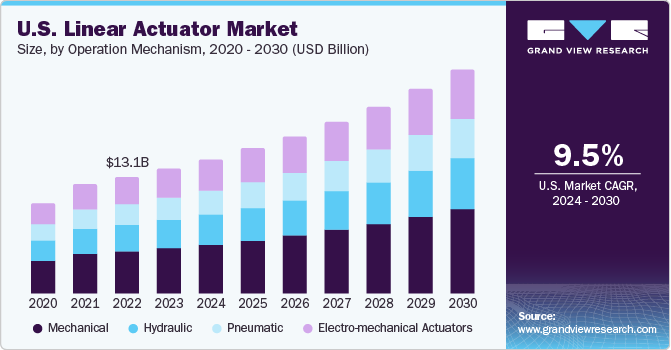
Linear actuators are utilized in a wide range of applications, including lighting control, window and door automation, and HVAC (Heating, Ventilation, and Air Conditioning) control systems in smart homes and buildings. Integrating actuators with dampers or valves allows the airflow and temperature within a building's HVAC system to be precisely regulated. This allows for optimal distribution of conditioned air to different zones or rooms, ensuring personalized comfort and energy savings. Linear actuators enable dynamic adjustments to airflow dampers, valve positions, and air outlet louvers, providing efficient temperature control and airflow management in line with occupants' needs, and force for the market. For instance, in October 2021, the Department of Energy (DOE) announced to invest nearly USD 61 million in smart buildings, accelerating renewable energy adoption and grid resilience. This increases the demand for the linear actuators market in the region.
Linear actuators are essential components in various applications within the aerospace and defense sectors. These sectors demand high-performance systems capable of precise and reliable motion control for a wide range of critical functions. The demand for linear actuators in aerospace sectors is driven by the need for precise and responsive motion control and the goal of reducing weight and enhancing safety measures.
Governments play a crucial role in regulating and setting standards for linear actuators to guarantee their quality, safety, and environmental sustainability. Government regulations across the globe are implemented to safeguard human health, promote environmental conservation, and minimize the risks associated with hazardous substances. While these measures are essential for consumer protection and sustainable practices, they can considerably impact the design, production, and supply of linear actuators. As a result, this may significantly impact the growth of the market. For instance, the European Union's Restriction of Hazardous Substances (RoHS) directive sets limitations on the number of hazardous substances that can be used in electrical as well as electronic equipment, including linear actuators.
Linear actuators are widely used in electric vehicle (EV) components such as motorized windows, seats, and sunroofs. In EVs, a linear actuator converts electrical energy into linear motion with very high efficiency, which is important for EVs where energy efficiency is critical. They can be used in various applications in EVs, which include controlling the movement of windows & sunroofs and adjusting the position of seats, among others. As the usage of EVs grows, so will the demand for linear actuators. In addition, as technology advances, linear actuators become more efficient, precise, and long-lasting. Hence, such factors increase the demand for linear actuators in various industries, providing lucrative opportunities for the growth of the market.
Market Concentration & Characteristics
Market growth stage is medium, and pace of the market growth is accelerating. The market is characterized by a high degree of innovation owing to integration with smart technologies, allowing for connectivity and communication with other components in the system. The integration often includes features such as remote monitoring and control through Internet of Things (IoT) platforms.
The market is also characterized by a high level of merger and acquisition (M&A) activity by the leading players. This is due to several factors, including the focus on developing energy-efficient linear actuators, customizable linear actuators with modular designs, and the need to consolidate in a rapidly growing market.
The market is also subject to several regulatory considerations. The regulations are essential for manufacturers and users to ensure product safety, reliability, and legal compliance. Manufacturers need to follow regulations related to product safety standards, environmental regulations, energy efficiency standards, CE marking, and labeling, among others.
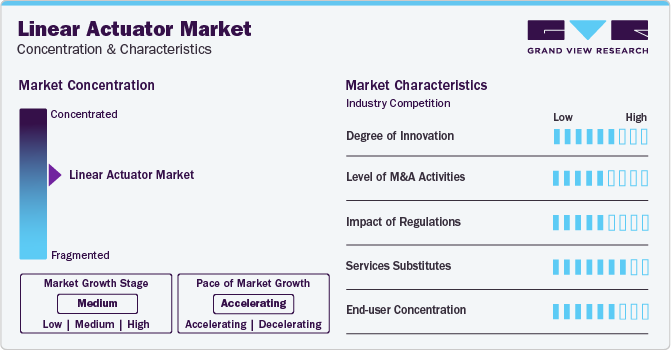
The threat of substitutes for linear actuators is higher in the market. Linear actuators are chosen based on factors such as precision, speed, force capacity, and environmental considerations. The threat of substitutes varies across industries and applications within the market. Market players need to continually innovate and offer unique value propositions to mitigate the impact of potential substitutes.
End-user concentration is a significant factor in the market. Several end-user industries are driving demand for linear actuators. Staying abreast of technological developments and market trends is crucial for businesses operating in this space.
Operation Mechanism Insights
The mechanical segment led the market and accounted for 36.5% in 2023. Mechanical actuators use a power source to generate physical movement. Almost every automated machine has one of these. The section is built with various components, the most important of which are the gearing, extension tube, motor, and screw assembly. Hence, such factors drive the mechanical segment growth.
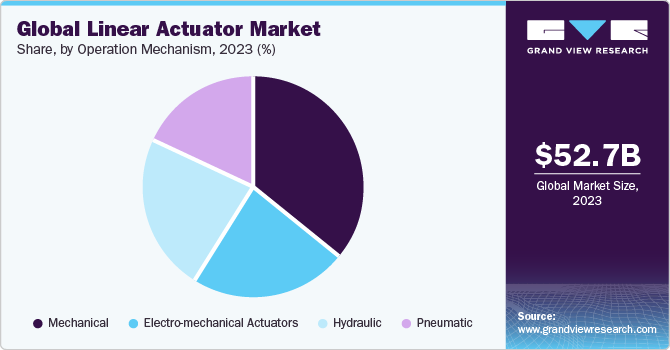
The hydraulic segment is anticipated to register considerable growth over the forecast period. One of the primary drivers for hydraulic mechanism linear actuators is their capability to generate high forces and torque capacity, making them ideal for heavy-duty applications, including lifting and positioning huge weights in industrial and construction environments. Technology advancements, such as the utilization of electro-hydraulic systems and the integration of sensors and control systems, have increased the efficiency and reliability of hydraulic actuators, boosting demand for these mechanisms in the market. Hence, such factors are anticipated to drive the growth of the segment over the forecast period.
Regional Insights
North America dominated the market and accounted for a revenue share of 34.8% in 2023. The increased adoption of automation in numerous industries, including aerospace and automotive, is driving demand for linear actuators in North America. The region's healthcare industry is also expanding rapidly, which is likely to increase demand for linear actuators for medical applications. Linear actuators are commonly utilized in the healthcare industry for a variety of applications, including hospital beds, patient lifts, and dentist chairs. The healthcare industry in North America relies on linear actuators for a wide range of applications, including patient positioning, hospital beds, medical equipment adjustment, and mobility aids. The growing aging population and advancements in medical technology have driven the demand for medical devices incorporating linear actuators.
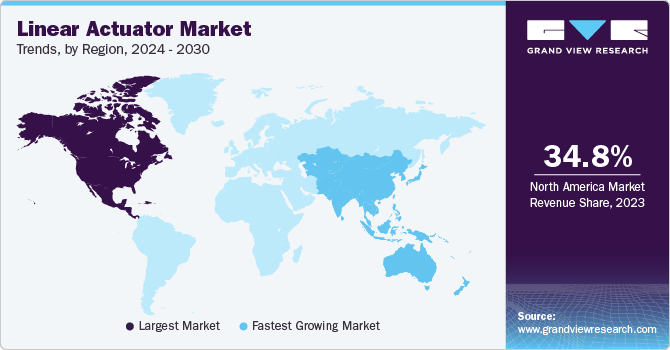
Asia Pacific is expected to hold the highest CAGR over the forecast period. The increasing popularity of electric vehicles (EVs) in countries like China and Japan is anticipated to boost the demand for linear actuators in Asia-Pacific. These actuators play a crucial role in various components of EVs. Moreover, the region is shifting towards renewable energy sources, driving the demand for linear actuators. Linear actuators are extensively utilized in a wide range of renewable energy applications, including solar tracking systems. These systems ensure the optimal alignment of solar panels with the sun to maximize energy generation.
Key Companies & Market Share Insights
Some of the key players operating in the market include Actuonix Motion Devices, BISHOP-WISECARVER, ElectroCraft, Emerson Electric Co., and IAI America, Inc.
-
Emerson Electric Co. has a presence across various industries, including industrial automation, manufacturing, and process control. The company’s broad industrial footprint allows it to offer linear actuators for a range of applications.
-
IAI America, Inc. incorporates innovative technologies into their linear actuators, such as intelligent automation features, advanced control systems, and precision mechanics.
Tolomatic, Inc., Firgelli Automations, Rollon Group, and Progressive Automations, Inc. are some of the emerging market participants in the linear actuator industry.
-
Progressive Automations Inc. is a manufacturer of electric linear actuators used in various applications such as marine, agriculture, home automation, and medical equipment.
-
Rollon Group focuses on manufacturing linear motion systems, including actuators and linear guides, for applications in robotics, automation, and other industrial sectors.
Key Linear Actuator Companies:
- Actuonix Motion Devices
- BISHOP-WISECARVER
- ElectroCraft
- Emerson Electric Co.
- Fabco-Air, Inc.
- IAI America, Inc.
- ISOTECH, INC.
- LINAK
- Progressive Automations Inc.
- Rollon Corp.
- SMC Corporation
- TiMOTION Technology Co. Ltd.
- Tolomatic USA
- Ultra Motion
- Venture MFG. Co.
Recent Developments
-
In May 2023, Motion Plus, LLC launched Motus1 (M1), a belt and screw-driven industrial linear positioning actuator. The M1 actuator use cases include assembly lines, packaging, material handling, palletizing, and gantries, among others. M1 actuator is available in three sizes - 95mm, 125mm, and 170mm.
-
In March 2023, Nanotec Electronic GmbH & Co. KG introduced NEMA 6, an external linear actuator with a 14mm flange. The actuator is ideal for laboratory automation, medical devices, and optical technology.
-
In January 2023, The Timken Company acquired Nadella Group, a European manufacturer of actuators & systems, telescopic rails, linear guides, and other industrial motion solutions from ICG plc to expand its linear motion portfolio.
Linear Actuator Market Report Scope
|
Report Attribute |
Details |
|
Market size value in 2024 |
USD 56.6 billion |
|
Revenue forecast in 2030 |
USD 94.3 billion |
|
Growth rate |
CAGR of 8.9% from 2024 to 2030 |
|
Base year for estimation |
2023 |
|
Historical data |
2018 - 2022 |
|
Forecast period |
2024 - 2030 |
|
Quantitative units |
Revenue in USD billion, and CAGR from 2024 to 2030 |
|
Report coverage |
Revenue forecast, company ranking, competitive landscape, growth factors, and trends |
|
Segments covered |
Operation mechanism, region |
|
Regional scope |
North America; Europe; Asia Pacific; Latin America; MEA |
|
Country scope |
U.S.; Canada; UK; Germany; France; Italy; Spain; China; India; Japan; Australia; South Korea; Brazil; Mexico; Argentina; UAE; Saudi Arabia; South Africa |
|
Key companies profiled |
Actuonix Motion Devices; BISHOP-WISECARVER; ElectroCraft; Emerson Electric Co.; Fabco-Air, Inc.; IAI America, Inc.; ISOTECH, INC.; LINAK; Progressive Automations Inc.; Rollon Corp.; SMC Corporation; TiMOTION Technology Co. Ltd.; Tolomatic USA; Ultra Motion; Venture MFG. Co. |
|
Customization scope |
Free report customization (equivalent up to 8 analysts working days) with purchase. Addition or alteration to country, regional & segment scope. |
|
Pricing and purchase options |
Avail customized purchase options to meet your exact research needs. Explore purchase options |
Global Linear Actuator Market Report Segmentation
The report forecasts revenue growth at global, regional, and at country level and provides an analysis of the latest trends in each of the sub-segments from 2018 to 2030. For this study, Grand View Research has segmented the global linear actuator market report based on operation mechanism and region:
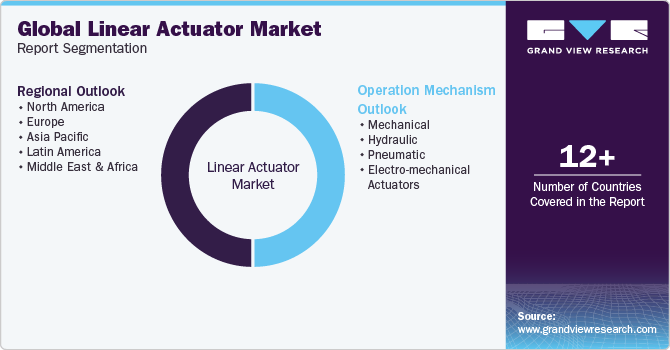
-
Operation Mechanism Outlook (Revenue, USD Billion, 2018 - 2030)
-
Mechanical
-
Hydraulic
-
Pneumatic
-
Electro-mechanical Actuators
-
-
Regional Outlook (Revenue, USD Billion, 2018 - 2030)
-
North America
-
U.S.
-
Canada
-
-
Europe
-
UK
-
Germany
-
France
-
Italy
-
Spain
-
-
Asia Pacific
-
China
-
India
-
Japan
-
Australia
-
South Korea
-
-
Latin America
-
Brazil
-
Mexico
-
Argentina
-
-
Middle East & Africa (MEA)
-
U.A.E.
-
Saudi Arabia
-
South Africa
-
-
Frequently Asked Questions About This Report
b. The global linear actuator market size was estimated at USD 52.67 billion in 2023 and is expected to reach USD 56.6 billion in 2024.
b. The global linear actuator market is expected to grow at a compound annual growth rate of 8.9% from 2024 to 2030 to reach USD 94.3 billion by 2030.
b. North America dominated the market and accounted for 34.8% in 2023. The increased adoption of automation in numerous industries, including aerospace and automotive, is driving demand for linear actuators in North America.
b. Some key players operating in the linear actuator market include Actuonix Motion Devices; BISHOP-WISECARVER; ElectroCraft; Emerson Electric Co.; Fabco-Air, Inc.; IAI America, Inc.; ISOTECH, INC.; LINAK; Progressive Automations Inc.; Rollon Corp.; SMC Corporation; TiMOTION Technology Co. Ltd.; Tolomatic USA; Ultra Motion; and Venture MFG. Co.
b. The rise in industrial automation and robotics is the primary factor propelling the linear actuator market. Linear actuators play an essential role as electromechanical devices that transform rotational motion into linear motion, enabling accurate control and movement across diverse applications.
We are committed towards customer satisfaction, and quality service.
"The quality of research they have done for us has been excellent."




